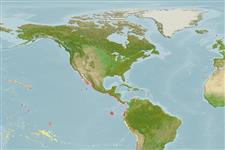Actinoptérygiens (poissons à nageoires rayonnées) >
Lophiiformes (Anglerfishes) >
Antennariidae (Frogfishes) > Antennariinae
Etymology: Antennatus: From Latin, antenna, antemna = sensory organ, that has got antennae (Ref. 45335).
Environnement / Climat / Gamme
Écologie
; marin récifal; profondeur 0 - 40 m (Ref. 9269), usually 0 - 20 m (Ref. 9269). Tropical, preferred ?; 27°N -
Eastern Pacific: Gulf of California to Peru, including the Cocos and Galapagos islands (Ref. 9269), and the Desventuradas Is. (Ref. 89357).
Taille / Poids / Âge
Maturity: Lm ? range ? - ? cm
Max length : 8.2 cm SL mâle / non sexé; (Ref. 9269)
Found on small recesses in rocky reefs and especially along walls. They blend almost perfectly with the background and appear like encrusting sponges (Ref. 5227).
Life cycle and mating behavior
Maturité | Reproduction | Frai | Œufs | Fécondité | Larves
Oviparous.
Schneider, M. and R.J. Lavenberg, 1995. Antennariidae. Ranisapos. p. 854-857. In W. Fischer, F. Krupp, W. Schneider, C. Sommer, K.E. Carpenter and V. Niem (eds.) Guia FAO para Identification de Especies para lo Fines de la Pesca. Pacifico Centro-Oriental. 3 Vols. FAO, Rome. (Ref. 9269)
Statut dans la liste rouge de l'IUCN (Ref. 115185)
CITES (Ref. 94142)
Not Evaluated
Menace pour l'homme
Harmless
Utilisations par l'homme
Plus d'informations
Taille/ÂgeCroissanceLongueur-poidsLongueur-longueurFréquences de longueursMorphométrieMorphologieLarvesDynamique des populations larvairesRecrutementAbondance
RéférencesAquacultureProfil d'aquacultureSouchesGénétiqueFréquences alléliquesHéritabilitéPathologiesTraitementMass conversion
CollaborateursImagesStamps, CoinsSonsCiguateraVitesseType de nageSurface branchialeOtolithesCerveauxVision
Outils
Articles particuliers
Télécharger en XML
Sources Internet
Estimates of some properties based on models
Phylogenetic diversity index (Ref.
82805): PD
50 = 0.5002 [Uniqueness, from 0.5 = low to 2.0 = high].
Bayesian length-weight: a=0.01995 (0.00906 - 0.04395), b=3.01 (2.83 - 3.19), in cm Total Length, based on all LWR estimates for this body shape (Ref.
93245).
Niveau trophique (Ref.
69278): 4.0 ±0.7 se; Based on size and trophs of closest relatives
Résilience (Ref.
69278): Haut, temps minimum de doublement de population inférieur à 15 mois (Fec assumed to be > 10,000).
Vulnérabilité (Ref.
59153): Low vulnerability (10 of 100) .
